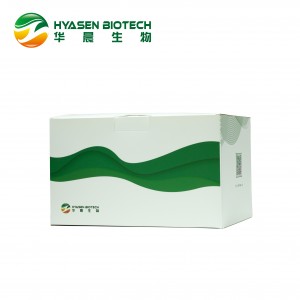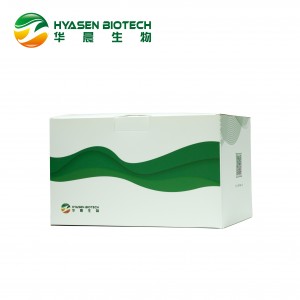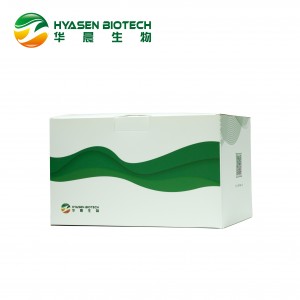
N-Glycan Kit
Product Description
This document provides information regarding the general care and use of N-Glycan Kit for the fast enzymatic release and rapid labeling of N-glycans. This protocol is validated using monoclonal antibodies and has also been tested to perform for a wide range of other N-linked glycoproteins. We recommend the user to confirm enzymatic release for their particular sample.
Components
N-Glycan Kit(24T)
|
Module |
Component |
HCP0031A |
|
Deglycosylation Module HCP0031A-1 |
IgG |
1.2 mg |
|
PNGase F |
45µL |
|
|
PNGase F buffer |
0.5mL |
|
|
Surfactant |
1.2mg*6 |
|
|
Labeling Module HCP0031A-2 |
MS reagent powder |
8.2mg*3 |
|
Anhydrous DMF |
1mL |
|
|
Clean-up Module HCP0031A-3 |
Elution Plate (96well) |
1 piece |
|
Elution Buffer |
5mL* 1 |
|
|
Sample Diluent |
5mL* 1 |
|
|
Sample Collection Module HCP0031A-4 |
8-tube Strips (200μL) |
100 pieces |
|
8-cap Strips |
100 pieces |
|
|
Collection plate(96well) |
1 piece |
|
|
Waste tray |
1 piece |
Protocol
User need to prepare below reagents and devices before you begin (One IgG sample as example):
(1) 0.85% Nacl, 100µL; acetonitrile( LC-MS grade);ultrapure water;
(2)15/85=ultrapure water/acetonitrile solution (v/v), 2mL; 1/9/90=formic acid/ultrapure water/acetonitrile(v/v) ,20mL;50 mM ammonium formate,PH=4.4 ,500mL;
(3) SPE vacuum pump; 96-well-plate negative pressure processor or positive pressure processor; Heating module or metal bath( 90℃and 50℃) ; vortex mixer;pipette.
Step 1:Rapid Deglycosylation
(1) Dilute IgG sample with 0.85% Nacl to get IgG finalconcentration at 2mg/mL.
(2) PNGase F buffer: dilute 1 vial surfactant (1.2mg/3.6mg)with (24μL/72μL))PNGase F buffer, mix and store at room temperature (this solution need to prepare before use) .
(3) Add 20μL IgG solution to 200μL reaction tube, add 3μL PNGase F buffer , pipette up and down to mix and then add 3.3μL ultrapure water, aspirate and dispense to mix.
(4) Add all above solution to heating module at 90℃,3 minutes, denature it , and then get it out from the heating module, and cool for 3 minutes at room temperature.
(5) Add 1.2μL PNGase F,aspirate and dispense to mix, heat 50℃, 5 minutes with heating module. User can prepare labeling reagent while waiting.
(6) Get it out from the heating module, and then cool for 3minutes at room temperature.
Step 2. Rapid Labeling of Glycosylamines
(1) Labeling reagent solution: dilute one vial labeling reagent (8.2mg/24.6m)with anhydrous DMF(60. 13μL/180.4μL), this solution need to be prepared before use), aspirate and dispense 5- 10 times to ensure the reagent is dissolved fully.
(2) Add 6μL labeling reagent solution to reaction tube, aspirate and dispense 5- 10 times to ensure mixing, and then allow the labeling reaction to proceed at room
temperature for 5 minutes.
(3) Add 179 μL acetonitrile, mix for next step.
Step 3: Clean-up of Labeled Glycosylamines
(1) Set up negative pressure processor or positive pressure processor and 96-well elution plate.
(2) Condition wells: add 200μL ultrapure water to the elution plate to condition the wells, collect the waste by the waste tray.
(3)Equilibrate wells: add 200μL 15/85 water/acetonitrile solution (v/v) to equilibrate wells, collect the waste by waste tray.
(4 ) Load sample:Load the acetonitrile diluted samplesand collect the waste by waste tray.
(5) Wash the wells with 600μL 1/9/90 formic acid/ultrapure water/acetonitrile(v/v) twice and collect the wast by waste tray.
(6) Remove the waste tray, and change it to collection plate.
(7)Wash the cell with 50μL elution buffer, elute glycans to the collection plate, and repeat this step.
(8)Add 200μL sample diluent, mix it.
Step 4. HILIC-FLR
(1) Chromatography column: ACQUITY UPLC® Glycan BEH Amide, 130 Å, 1.7 μm, 2. 1 x 150 mm(waters part #186004742).
(2) Temperature of the column:60 °C
(3) Liquid phase A:50 mM ammonium formate solution ( LC-MS grade is recommended), pH=4.4.
(4) Liquid phase B:100% acetonitrile( LC-MS grade is recommended).
(5) Flow rate: 0.4 mL/min;
(6) Gradient:
|
Time(min) |
Flow rate (mL/min) |
%A |
%B |
Curve |
|
0 |
0.4 |
25 |
75 |
6 |
|
35 |
0.4 |
46 |
54 |
6 |
|
36.5 |
0.2 |
100 |
0 |
6 |
|
39.5 |
0.2 |
100 |
0 |
6 |
|
43. 1 |
0.2 |
25 |
75 |
6 |
|
47.6 |
0.4 |
25 |
75 |
6 |
|
55 |
0.4 |
25 |
75 |
6 |
(7)FLR wavelengths: EX 265/EM 425 nm
(8)FLR sampling rate: 2 Hz
(9)Injection vol.: 10μL
Please note that above parameters based on the machine equiped with“ACQUITY® RDa”LCMS, the user can adjust the parameter accordingly on other equipment.
Storage
|
Reagent |
Storage |
|
IgG |
2-8℃, 12 months |
|
PNGase F |
-25 ~ – 15℃℃ , 12 months , avoid freeze/thaw cycles |
|
PNGase F buffer |
2-8℃, 12 months |
|
Surfactant |
Room Temperature, 12 months |
|
MS reagent Powder |
2-8℃, 12 months,keep in dark |
|
Anhydrous DMF |
Room temperature, 12 months |
|
Elution Buffer |
Room temperature, 12 months |
|
Sample diluent |
Room temperature, 12 months |
|
96 well elution plate |
Room temperature, once opened, the unused well need to be sealed with the plastic paraffin film and keep desiccant at room temperature |
|
200μL strips of 8 tubes, strips of 8 caps, 96 well collection plate,waste tray |
Room temperature,96 well collection plate be sealed and keep desiccant at room temperature |
Notes
For your safety and health, please wear lab coat and gloves.
Use clean tips each time
Please follow the manual to store and use the reagents














